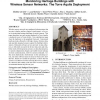Free Online Productivity Tools
i2Speak
i2Symbol
i2OCR
iTex2Img
iWeb2Print
iWeb2Shot
i2Type
iPdf2Split
iPdf2Merge
i2Bopomofo
i2Arabic
i2Style
i2Image
i2PDF
iLatex2Rtf
Sci2ools
IPSN
2009
Springer
2009
Springer
Monitoring heritage buildings with wireless sensor networks: The Torre Aquila deployment
Wireless sensor networks are untethered infrastructures that are easy to deploy and have limited visual impact—a key asset in monitoring heritage buildings of artistic interest. This paper describes one such system deployed in Torre Aquila, a medieval tower in Trento (Italy). Our contributions range from the hardware to the graphical front-end. Customized hardware deals efficiently with high-volume vibration data, and specially-designed sensors acquire the building’s deformation. Dedicated software services provide: i) data collection, to efficiently reconcile the diverse data rates and reliability needs of heterogeneous sensors; ii) data dissemination, to spread configuration changes and enable remote tasking; iii) time synchronization, with low memory demands. Unlike most deployments, built directly on the operating system, our entire software layer sits atop our TeenyLIME middleware. Based on 4 months of operation, we show that our system is an effective tool for assessing t...
| Added | 20 May 2010 |
| Updated | 20 May 2010 |
| Type | Conference |
| Year | 2009 |
| Where | IPSN |
| Authors | Matteo Ceriotti, Luca Mottola, Gian Pietro Picco, Amy L. Murphy, Stefan Guna, Michele Corrà, Matteo Pozzi, Daniele Zonta, Paolo Zanon |
Comments (0)

